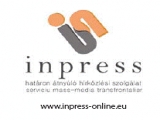Home
Downloads
2014+
The journalists, radio and television broadcasting professionals from Csongrád and Timiş counties work in close cooperation to implement a media project within the Hungary–Romania Cross-Border Cooperation Programme.

As a result of this cooperation, besides the common news portal and magazine many radio and television programmes are being prepared in order to bring the inhabitants of the neighbouring counties closer, and let them know, but most of all make them want to know more about each other.
The logo of the news service "Inpress” (coming from the English expression “ipress” which is known worldwide), as well as the name of the joint publication "LiteratHU-R” refer to the present connections between the two counties which are to be further developed.
The project is implemented by Megyeszolgálat Szolgáltató és Kereskedelmi Non-Profit Kft., which is the property of Csongrád County Self-government, and Integratio Foundation, the partner from Timiş County, with a total budget of 198 870 EUR. The goal of the project is to enhance cross-border newscast in close cooperation with representatives of existing local media, journalists, radio and television broadcasting professionals.
The project was launched on 9th March 2010 in Timişoara, where the implementers of the project introduced themselves to the Hungarian and Romanian news casting professionals form Romania. This was a great opportunity to bring forward the outcomes of a so called “acquaintance survey”, which brought into spotlight just how well people living on the two sides of the border know each other and one another’s problems. The survey showed that those questioned have relatively limited knowledge of each other. Another interesting result was that Timiş County inhabitants showed more interest towards Csongrád County, than vice versa, underpinning the need for cooperation through joint efforts. The actual improvements and the success of the common work will be surveyed before closing the project, together with future co-operation possibilities.
The first issue of the common magazine – “LiteratHU-R” – was published (http://www.inpress-online.eu/?mod=ujsag&lg=hu) by the time of the opening event, which deals with topics of common interest to those living on both sides of the border, such as historical facts, local news, tourist attractions, events, etc. in as many as 16 pages. The joint website which publishes bilingual news and articles in the above topics (www.inpress-online.eu) was also introduced to the public at this event.
The fist workshop was also organized in Timişoara, 9th July 2010, with the participation of both Hungarian and Romanian journalists as well as acclaimed media professionals. Presentations were held on the role of Csongrád County Government in cross-border newscast, or, cross-border media connections seen from Budapest or Timisoara. Media partners participating in the project also presented their existing cross-border relations.
A promotional video, introducing the project in a dynamic and innovative way (available: www.inpress-online.eu) was also introduced in the workshop. At the end of the day, participants were invited to visit the editorial offices of the media partners involved in the project.
The first common television programme was aired in June 2010, with the cooperation of AnalogTV from Timişoara and Egymásért Egyesület from Mórahalom. During the preparation of this programme, television professionals from Csongrád and Timiş counties worked side-by side both inland and across the border. The programmes in all cases are oriented towards one major topic. For example, tourism (general information, events, statistical data) was the main theme in the second edition. Other topics revealed how the “Szeged Open-air Games” can attract people from Timiş County or Romania, or presented the performance made by cheerleader groups from Ásotthalom and Újszentiván together with Romanian dancers in the local melon-feast, even with joint choreographies. The programme highlighted how popular the famous dish of Hungarian gastro-culture, the Szeged fish-stew is on the other side of the border, since many travel to Szeged solely to have a taste of it.
The preparatory works of joint radio programmes have also begun. Local radios will have weekly programmes on cross-border possibilities, to let the people listening get used to the systematic broadcasting, and make them look forward to the new programmes for information that they cannot, or hardly gain from elsewhere.
Television and radio programmes generally address themes which actually influence the everyday life of inhabitants on both sides of the border. Accordingly, upcoming programmes will feature themes like starting the school year, permeability of tertiary education – considering EU membership of the two countries –, and they also report on co-operation in healthcare (such as the joint application of Hospitals of Szentes and Jimbolia), or present the role of Kaáli Institution from Szeged on offering aid to childless families on both sides of the border.
In addition, these programmes expose the current situation of the labour market, which is especially interesting, because many residents who cannot find a job in the cross-border region are pressed to take jobs on the other side of the border in order to support their families.
Living with the words of a famous Hungarian writer, Istvan Örkény “Every chance bears the hope” – Anna Magyar, president of Csongrád County General Assembly, introduced the work of the project team to the inhabitants of the border area. As she mentioned, this project offers an infinite number of opportunities that help the residents of the cross-border area to get to know each other and want to know more about each-other, but also to take advantage of the wide range of the co-operation possibilities around.
The project is co-founded by the EU with an amount of 166 724 Euro ERDF.
The project is implemented between: 1 December 2009 – 30 November 2010.